ECU MAZDA MODEL 3 HATCHBACK 2007 Quick Tips (in English)
[x] Cancel search | Manufacturer: MAZDA, Model Year: 2007, Model line: MODEL 3 HATCHBACK, Model: MAZDA MODEL 3 HATCHBACK 2007Pages: 14, PDF Size: 2.24 MB
Page 6 of 14
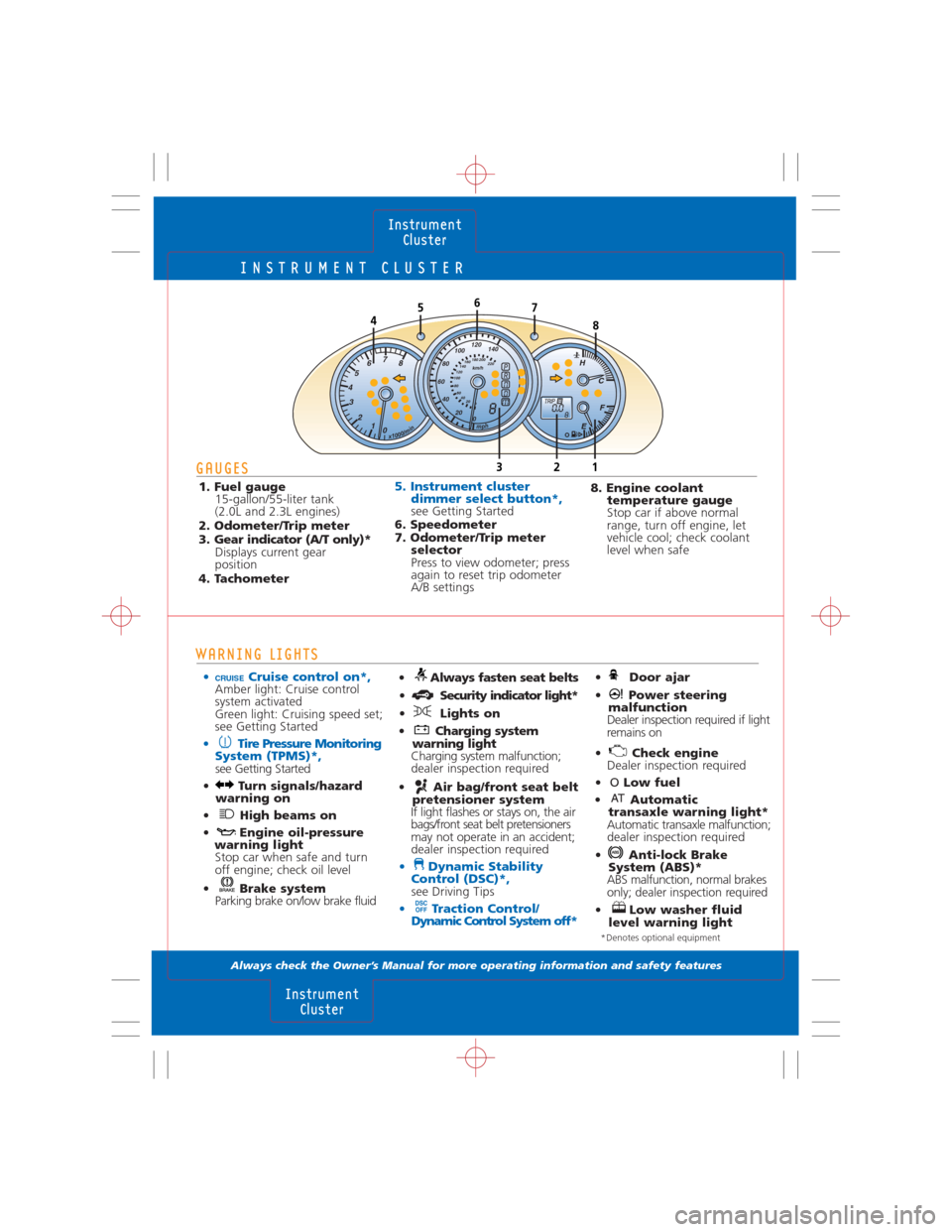
INSTRUMENT CLUSTER
Always check the Owner’s Manual for more operating information and safety features
WARNING LIGHTS
• Cruise control on*,Amber light: Cruise control
system activated
Green light: Cruising speed set;
see Getting Started
• Tire Pressure Monitoring
System (TPMS)*,
see Getting Started
• Turn signals/hazard
warning on
• High beams on
• Engine oil-pressure
warning light
Stop car when safe and turn
off engine; check oil level
• Brake system
Parking brake on/low brake fluid
GAUGES
1. Fuel gauge
15-gallon/55-liter tank
(2.0L and 2.3L engines)
2. Odometer/Trip meter
3. Gear indicator (A/T only)*
Displays current gear
position
4. Tachometer
• Always fasten seat belts
• Security indicator light*
• Lights on
• Charging system
warning light
Charging system malfunction;
dealer inspection required
• Air bag/front seat belt
pretensioner system
If light flashes or stays on, the air
bags/front seat belt pretensioners
may not operate in an accident;
dealer inspection required
• Dynamic Stability
Control (DSC)*,
see Driving Tips
• Traction Control/
Dynamic Control System off*DSC
OFF
5. Instrument cluster
dimmer select button*,
see Getting Started
6. Speedometer
7. Odometer/Trip meter
selector
Press to view odometer; press
again to reset trip odometer
A/B settings
Instrument
Cluster
Instrument
Cluster
nim/0001x
H
P
TRIPA80.0
RNDM8
C
F
E
5748
6
1 32
hpm
km/h
80220 200 180
160
140
120
100
60
40
20
0
0 20 40 6080100120
1400 1 2 3 4567
8
• Door ajar
• Power steering
malfunction
Dealer inspection required if light
remains on
• Check engine
Dealer inspection required
• OLow fuel
• Automatic
transaxle warning light*
Automatic transaxle malfunction;
dealer inspection required
• Anti-lock Brake
System (ABS)*
ABS malfunction, normal brakes
only; dealer inspection required
• Low washer fluid
level warning light
8. Engine coolant
temperature gauge
Stop car if above normal
range, turn off engine, let
vehicle cool; check coolant
level when safe
CRUISE
*Denotes optional equipment
Page 7 of 14
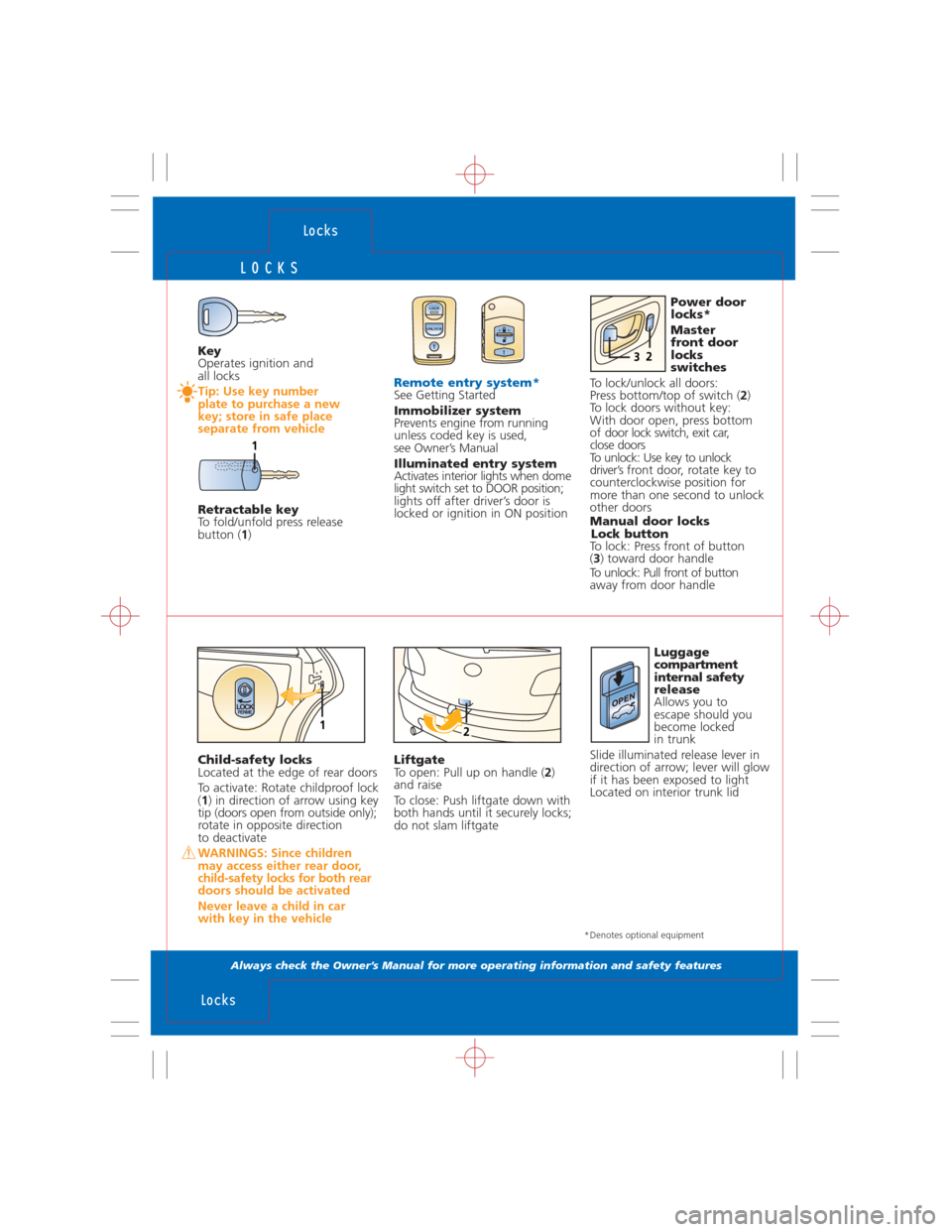
LOCKS
Always check the Owner’s Manual for more operating information and safety features
Locks
Locks
Key
Operates ignition and
all locks
Tip: Use key number
plate to purchase a new
key; store in safe place
separate from vehicle
Retractable key
To fold/unfold press release
button (1)
Remote entry system*See Getting Started
Immobilizer system
Prevents engine from running
unless coded key is used,
see Owner’s Manual
Illuminated entry system
Activates interior lights when dome
light switch set to DOOR position;
lights off after driver’s door is
locked or ignition in ON positionPower door
locks*
Master
front door
locks
switches
To lock/unlock all doors:
Press bottom/top of switch (2)
To lock doors without key:
With door open, press bottom
of door lock switch, exit car,
close doors
To unlock: Use key to unlock
driver’s front door, rotate key to
counterclockwise position for
more than one second to unlock
other doors
Manual door locks
Lock button
To lock: Press front of button
(3) toward door handle
To unlock: Pull front of button
away from door handle
LOCK
UNLOCK
Child-safety locks
Located at the edge of rear doors
To activate: Rotate childproof lock
(1) in direction of arrow using key
tip (doors open from outside only);
rotate in opposite direction
to deactivate
WARNINGS: Since children
may access either rear door,
child-safety locks for both rear
doors should be activated
Never leave a child in car
with key in the vehicle
Liftgate
To open: Pull up on handle (2)
and raise
To close: Push liftgate down with
both hands until it securely locks;
do not slam liftgateLuggage
compartment
internal safety
release
Allows you to
escape should you
become locked
in trunk
Slide illuminated release lever in
direction of arrow; lever will glow
if it has been exposed to light
Located on interior trunk lid
LOCKFERME12
LOCK UNLOCK
23
1
*Denotes optional equipment
Page 9 of 14
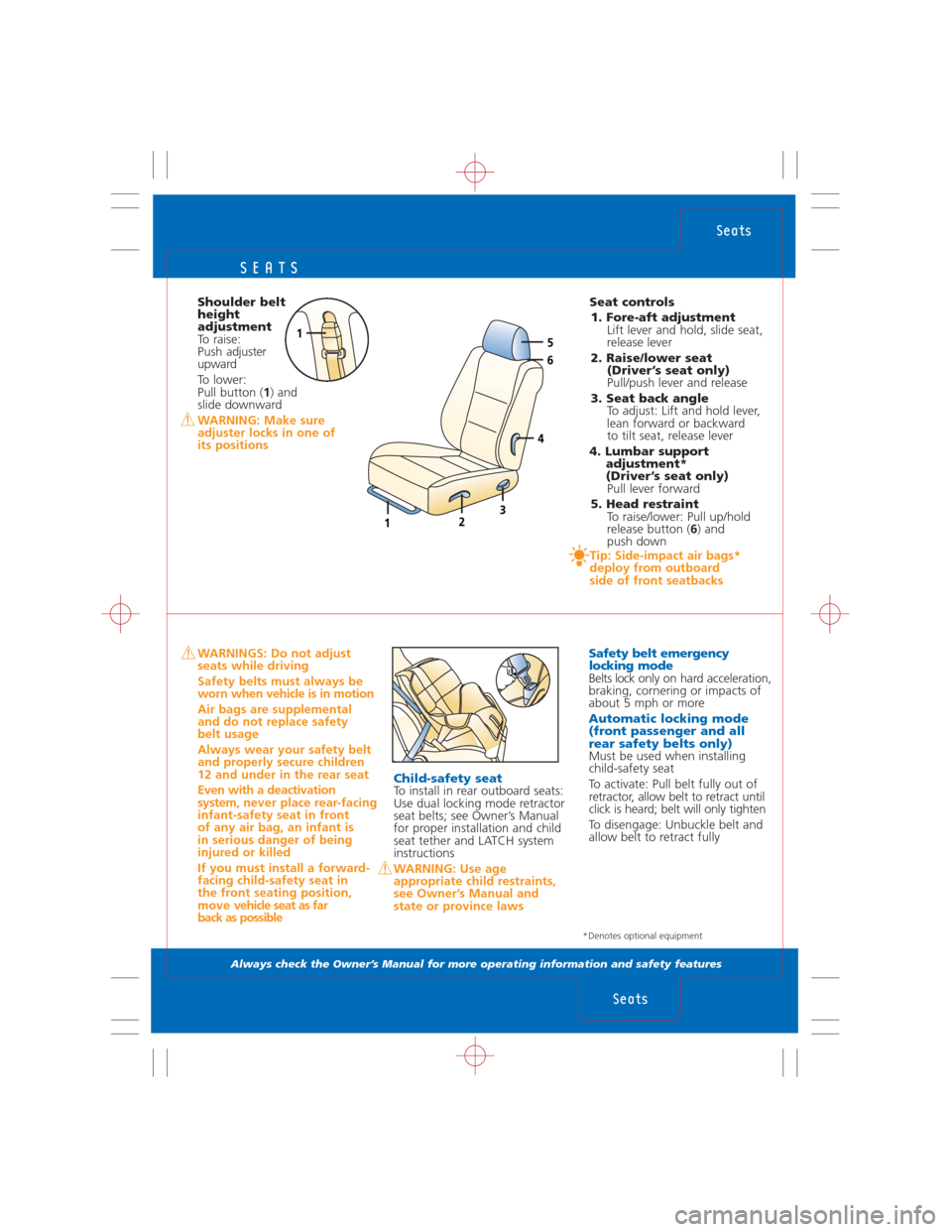
SEATS
Always check the Owner’s Manual for more operating information and safety features
Shoulder belt
height
adjustment
To raise:
Push adjuster
upward
To lower:
Pull button (1) and
slide downward
WARNING: Make sure
adjuster locks in one of
its positions
Seat controls
1. Fore-aft adjustment
Lift lever and hold, slide seat,
release lever
2. Raise/lower seat
(Driver’s seat only)
Pull/push lever and release
3. Seat back angle
To adjust: Lift and hold lever,
lean forward or backward
to tilt seat, release lever
4. Lumbar support
adjustment*
(Driver’s seat only)
Pull lever forward
5. Head restraint
To raise/lower: Pull up/hold
release button (6) and
push down
Tip: Side-impact air bags*
deploy from outboard
side of front seatbacks
Seats
Seats
WARNINGS: Do not adjust
seats while driving
Safety belts must always be
worn when vehicle is in motion
Air bags are supplemental
and do not replace safety
belt usage
Always wear your safety belt
and properly secure children
12 and under in the rear seat
Even with a deactivation
system,never place rear-facing
infant-safety seat in front
of any air bag, an infant is
in serious danger of being
injured or killed
If you must install a forward-
facing child-safety seat in
the front seating position,
move vehicle seat as far
back as possibleSafety belt emergency
locking mode
Belts lockonly on hard acceleration,
braking, cornering or impacts of
about 5 mph or more
Automatic locking mode
(front passenger and all
rear safety belts only)
Must be used when installing
child-safety seat
To activate: Pull belt fully out of
retractor, allow belt to retract until
click is heard; belt will only tighten
To disengage: Unbuckle belt and
allow belt to retract fully
Child-safety seatTo install in rear outboard seats:
Use dual locking mode retractor
seat belts; see Owner’s Manual
for proper installation and child
seat tether and LATCH system
instructions
WARNING: Use age
appropriate child restraints,
see Owner’s Manual and
state or province laws
1
*Denotes optional equipment
1
5
4
6
23
Page 10 of 14
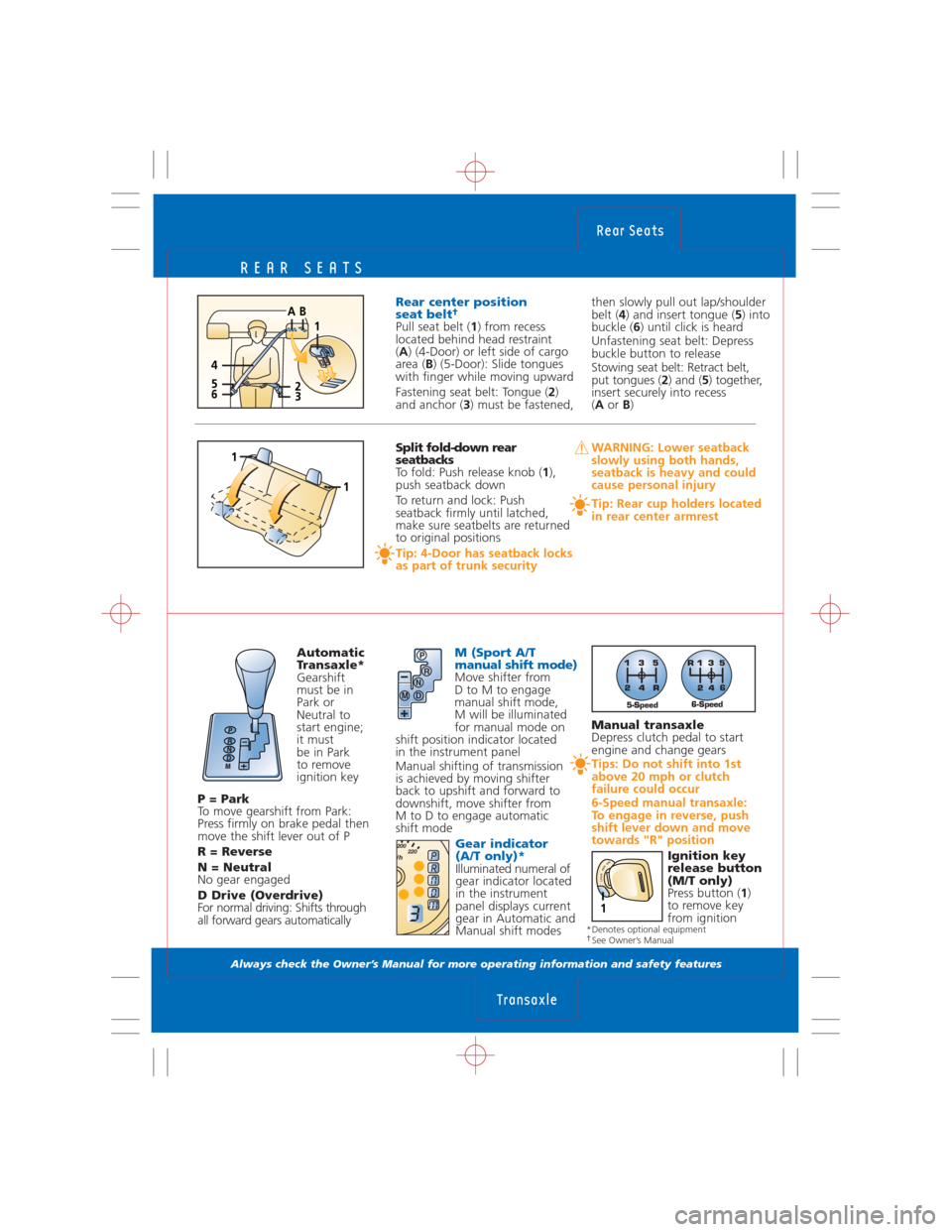
REAR SEATS
Always check the Owner’s Manual for more operating information and safety features
Automatic
Transaxle*
Gearshift
must be in
Park or
Neutral to
start engine;
it must
be in Park
to remove
ignition key
P = Park
To move gearshift from Park:
Press firmly on brake pedal then
move the shift lever out of P
R = Reverse
N = Neutral
No gear engaged
D Drive (Overdrive)
For normal driving: Shifts through
all forward gears automatically
Rear Seats
Transaxle
Rear center position
seat belt†
Pull seat belt (1) from recess
located behind head restraint
(A) (4-Door) or left side of cargo
area (B) (5-Door): Slide tongues
with finger while moving upward
Fastening seat belt: Tongue (2)
and anchor (3) must be fastened,then slowly pull out lap/shoulder
belt (4) and insert tongue (5) into
buckle (6) until click is heard
Unfastening seat belt: Depress
buckle button to release
Stowing seat belt: Retract belt,
put tongues (2) and (5) together,
insert securely into recess
(A orB)
M (Sport A/T
manual shift mode)
Move shifter from
D to M to engage
manual shift mode,
M will be illuminated
for manual mode on
shift position indicator located
in the instrument panel
Manual shifting of transmission
is achieved by moving shifter
back to upshift and forward to
downshift, move shifter from
M to D to engage automatic
shift mode
Gear indicator
(A/T only)*
Illuminated numeral of
gear indicator located
in the instrument
panel displays current
gear in Automatic and
Manual shift modesManual transaxle
Depress clutch pedal to start
engine and change gears
Tips: Do not shift into 1st
above 20 mph or clutch
failure could occur
6-Speed manual transaxle:
To engage in reverse, push
shift lever down and move
towards "R" position
Ignition key
release button
(M/T only)
Press button (1)
to remove key
from ignition
P
R
N
D M
LOCKACCON
1
6
5-Speed6-Speed
2365
1
4
AB
Split fold-down rear
seatbacks
To fold: Push release knob (1),
push seatback down
To return and lock: Push
seatback firmly until latched,
make sure seatbelts are returned
to original positions
Tip: 4-Door has seatback locks
as part of trunk securityWARNING: Lower seatback
slowly using both hands,
seatback is heavy and could
cause personal injury
Tip: Rear cup holders located
in rear center armrest
1
1
PRNDM
h
/h220 200
3*Denotes optional equipment†See Owner’s Manual
Page 13 of 14
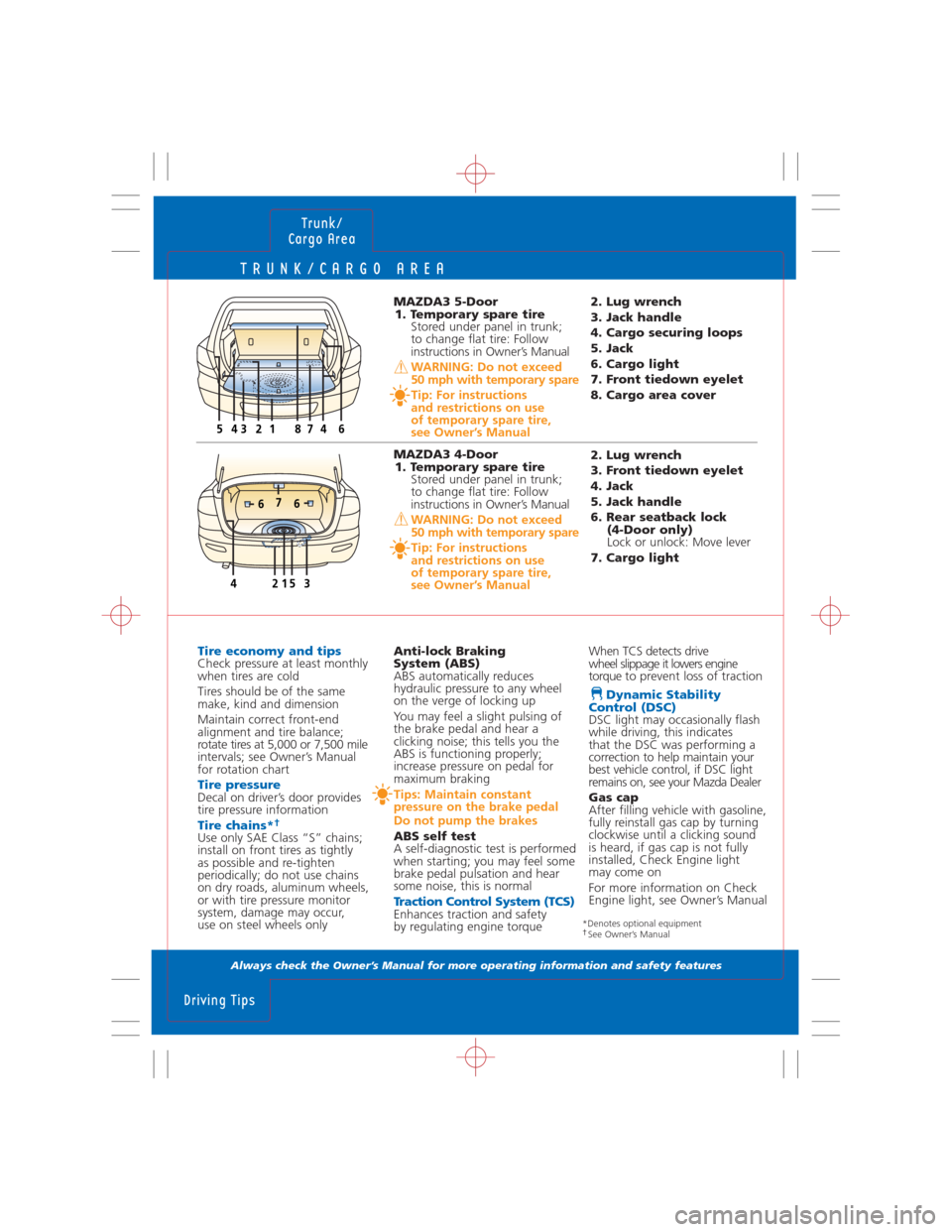
TRUNK/CARGO AREA
Always check the Owner’s Manual for more operating information and safety features
Trunk/
Cargo Area
Driving Tips
When TCS detects drive
wheel slippage it lowers engine
torque to prevent loss of traction
Dynamic Stability
Control (DSC)
DSC light may occasionally flash
while driving, this indicates
that the DSC was performing a
correction to help maintain your
best vehicle control, if DSC light
remains on, see your Mazda Dealer
Gas cap
After filling vehicle with gasoline,
fully reinstall gas cap by turning
clockwise until a clicking sound
is heard, if gas cap is not fully
installed, Check Engine light
may come on
For more information on Check
Engine light, see Owner’s Manual
MAZDA3 5-Door
1. Temporary spare tire
Stored under panel in trunk;
to change flat tire: Follow
instructions in Owner’s Manual
WARNING: Do not exceed
50 mph with temporary spare
Tip: For instructions
and restrictions on use
of temporary spare tire,
see Owner’s Manual
Tire economy and tips
Check pressure at least monthly
when tires are cold
Tires should be of the same
make, kind and dimension
Maintain correct front-end
alignment and tire balance;
rotate tires at 5,000 or 7,500 mile
intervals; see Owner’s Manual
for rotation chart
Tire pressure Decal on driver’s door provides
tire pressure information
Tire chains*†
Use only SAE Class “S” chains;
install on front tires as tightly
as possible and re-tighten
periodically; do not use chains
on dry roads, aluminum wheels,
or with tire pressure monitor
system, damage may occur,
use on steel wheels onlyAnti-lock Braking
System (ABS)
ABS automatically reduces
hydraulic pressure to any wheel
on the verge of locking up
You may feel a slight pulsing of
the brake pedal and hear a
clicking noise; this tells you the
ABS is functioning properly;
increase pressure on pedal for
maximum braking
Tips: Maintain constant
pressure on the brake pedal
Do not pump the brakes
ABS self test
A self-diagnostic test is performed
when starting; you may feel some
brake pedal pulsation and hear
some noise, this is normal
Traction Control System (TCS)Enhances traction and safety
by regulating engine torque 2. Lug wrench
3. Jack handle
4. Cargo securing loops
5. Jack
6. Cargo light
7. Front tiedown eyelet
8. Cargo area cover
MAZDA3 4-Door
1. Temporary spare tire
Stored under panel in trunk;
to change flat tire: Follow
instructions in Owner’s Manual
WARNING: Do not exceed
50 mph with temporary spare
Tip: For instructions
and restrictions on use
of temporary spare tire,
see Owner’s Manual
2. Lug wrench
3. Front tiedown eyelet
4. Jack
5. Jack handle
6. Rear seatback lock
(4-Door only)
Lock or unlock: Move lever
7. Cargo light
164432587
2
7
415
6
6
3
*Denotes optional equipment†See Owner’s Manual